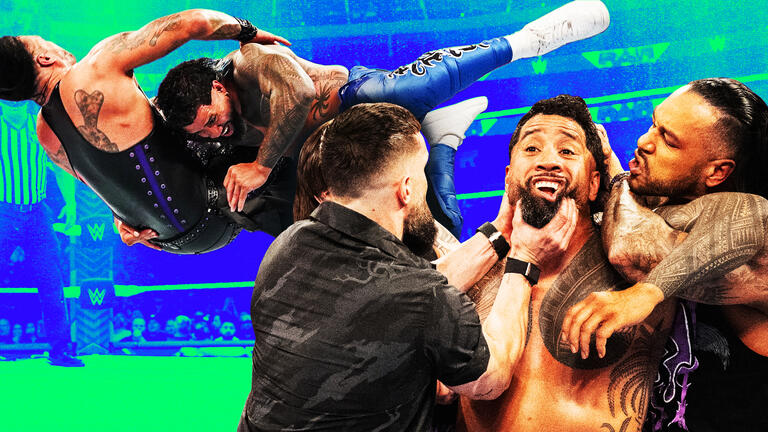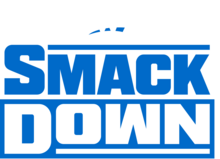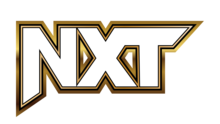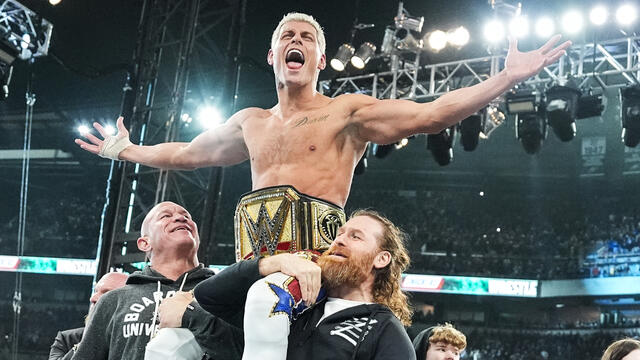
14 Superstars you didn't know appeared in WWE

Making it to WWE is the dream of every Superstar that ever pulled on a pair of spandex tights. But what about making it in WWE? That’s when things get a little trickier.
While Superstars like John Cena and The Undertaker have made their names synonymous with WWE’s brand, competitors like The Public Enemy and Crowbar are hardly remembered for their stints in Mr. McMahon’s domain. They didn’t even make the first printing of the WWE Encyclopedia!
Here, WWE Classics reveals rare footage of established Superstars who made limited or “one night only” appearances in WWE. Blink and you’ll miss ’em.
Crowbar
A darling of the indie set in the mid-90s, “Dangerous” Devon Storm built an east coast following thanks to a series of innovative barnburners against the likes of Sabu and 2 Cold Scorpio. After competing in WWE’s forgettable Light Heavyweight Title tournament, the New Jersey native found his greatest mainstream success in WCW alongside David Flair as the manic Crowbar. Discovered by Ric Flair’s son in a gas station, the gutsy flier captured the Cruiserweight, Hardcore and Tag Team Titles during his rewarding time with WCW.
Although he was not part of the infamous 2001 WCW invasion, Crowbar did turn up in WWE two years later in September 2003. Then spending much of his time working as a physical therapist, Crowbar re-emerged on the national wrestling scene with little fanfare as he struggled against Sean O’Haire on Velocity. After being completely obliterated by Scott Steiner on Sunday Night Heat, Crowbar quietly exited WWE.
The Public Enemy
Homegrown stars of the original ECW, plus-sized hip-hoppers Johnny Grunge and “Flyboy” Rocco Rock helped popularize the use of tables, ladders and chairs in pro wrestling during their stint with the renegade promotion in the mid-90s. The team transitioned surprisingly well to WCW in 1996 with a run that peaked in September of that year when they upset Harlem Heat for the WCW Tag Team Championships.
Grunge & Rock looked poised to capture the tag titles in the three major North American promotions when they joined WWE in 1999. Unfortunately, after a somewhat promising Raw debut against Edge & Gangrel, the duo hit a roadblock known as The Acolytes. A March run-in with Faarooq & Bradshaw on Sunday Night Heat resembled something closer to a televised mugging than a traditional wrestling match and saw to it that the team’s WWE tenure was a short one.
Baron Von Raschke
“That is all the people need to know!”
Those words were long associated with Baron Von Raschke, one of the most ruthless individuals to have competed inside the squared circle. The master of the “Brain Claw,” Von Raschke’s main stomping grounds in his career were Verne Gagne’s American Wrestling Association as well as various National Wrestling Alliance territories, where he garnered a number of championships in both singles and tag team competition.
The Baron has long been thought of as a Midwestern staple, but he actually had two stints in the Northeast with WWE. In 1977, the ghastly German outraged WWE fans when he took their beloved WWE Champion, Bruno Sammartino, to the limit on a few occasions. The Baron returned again in 1988, successfully leading The Powers of Pain into battle against The Bolsheviks at SummerSlam.
Great Sasuke
Masked Japanese sensation The Great Sasuke was one of the architects of the cruiserweight revolution of the 1990s. Alongside innovative stars like Jushin “Thunder” Liger and Ultimo Dragon, Sasuke played a major role in upping the pace of sports-entertainment contests while bringing daring high-risk maneuvers into the mainstream.
While most closely associated with the Japanese promotion Michinoku Pro Wrestling, Sasuke made his first major North American appearance as part of a blistering Six-Man Tag Team Match on ECW’s debut pay-per-view Barely Legal. Months later, the flier appeared in WWE, defeating Taka Michinoku in a thrilling bout at In Your House: Canadian Stampede. The next night on Raw, the two talented lightweights went at it again, but Sasuke returned to Japan before making a serious dent in WWE.
Kevin Von Erich
When you think of the relationship between the Von Erich family and WWE, two immediate things should come to mind: Kerry Von Erich’s successful turn in the early ’90s as The Texas Tornado and the family’s emotional induction into the WWE Hall of Fame in 2009.
But in the late 1970s, with the popularity of their Dallas-based World Class Championship Wrestling on the rise, two of the adored Von Erich boys competed in overlooked WWE bouts in historic Madison Square Garden. “The Yellow Rose of Texas” David Von Erich ventured into the “World’s Most Famous Arena” on Nov. 19, 1979, to compete victoriously against Irishman Davey O’Hannon. Two months later, big brother Kevin made a successful MSG debut by defeating future WWE Hall of Famer Johnny Rodz on Jan. 21, 1980. Kevin returned to WWE television nearly two decades later in his beloved Dallas to take part in 2005’s “WWE Homecoming” event.
Samoa Joe
Samoa Joe became an icon on the independent wrestling scene throughout much of the 2000s by treating his opponents’ heads like they were soccer balls. A rival of both Daniel Bryan and CM Punk during their early years with the Ring of Honor promotion, the hard-hitting Samoan even battled Kenta Kobashi in the Japanese icon’s most famous North American match.
Joe earned his ardent fan base the hard way. But before he compelled supporters to chant “Joe is going to kill you!” at his shaken opponents, the near 300-pounder made a sole WWE appearance in March 2001. Competing on WWE Jakked only a few years into his career, a young Joe struggled against former WWE Light Heavyweight Champion Essa Rios in an inauspicious national debut. The burly Samoan would go on to kick the teeth out of every major independent wrestler around, but he would not be seen in WWE again.
Kevin Sullivan
For more than two decades, Kevin Sullivan carved out a persona unlike anyone else in the wrestling industry, all of which happened following a modestly successful tenure in WWE.
A stocky thug from the Boston area, Sullivan horrified fans in Florida when he began presenting himself as Satan incarnate. He went a different route in the 1980s in WCW, re-emerging as a tormenting jock alongside Mike Rotunda and Steve Williams in The Varsity Club. It came full circle for Sullivan in the mid-90s when he became “The Taskmaster” — the macabre leader of The Dungeon of Doom.
Sullivan was a key figure for WCW both in the ring and behind the scenes, which has led many to think he spent his entire career in Atlanta. In truth, the Massachusetts native started out with WWE in the mid-70s, batting the likes of Spiros Arion, Bruiser Brody and Ivan Koloff. Sullivan’s hard work and never-say-die attitude made him a WWE fan favorite — a situation he would rarely be in for the remainder of his career.
KroniK
The singles careers of Brian Adams and Bryan Clark in WWE are well-documented as Crush and Adam Bomb, respectively. But an oft-forgotten fact about the duo is that their WCW tag team, KroniK, transitioned to WWE in fall 2001. Recruited by Stevie Richards to help defend him against The Undertaker, the former WCW Tag Team Champions only competed in a two matches — first defeating Kaientai on SmackDown and then losing to WCW Tag Team Champions Kane & The Undertaker three days later at Unforgiven.
Although they dominated the tag ranks in WCW, KroniK failed to live up to their “breaking necks and cashing checks” catchphrase after the collapse of that company. Their short tenure in WWE was surprising considering both individuals stood at nearly 7-feet tall and had a combined weight of almost 600 pounds. Alas, their loss to The Brother of Destruction would be the final WWE appearance of both Adams and Clark.
Tony Schiavone
At the height of the Monday Night War, veteran broadcaster Tony Schiavone’s voice was as vital to the onscreen product of World Championship Wrestling as Jim Ross’ Oklahoma growl was to WWE. First introduced to sports-entertainment fans as the host of the weekly Jim Crockett Promotions program on TBS, Schiavone became the lead announcer for WCW’s Nitro when it debuted in 1995.
But in 1989, in-between his stints with those two organizations, Schiavone occupied a seat at WWE’s announce table alongside Jesse “The Body” Ventura. Smooth and straightforward in his commentary, Schiavone handled play-by-play duties at both SummerSlam ’89 and Royal Rumble ’90. His time with WWE ended early that same year as he headed to WCW, where he would finish out his career as a sports-entertainment broadcaster.
The Fabulous Freebirds
One of the most prolific tag teams in wrestling history enjoyed phenomenal success no matter where they went. From WCW to the AWA, from the UWF to WCCW, The Fabulous Freebirds lit it up big time. If promoters wanted charisma, flamboyance and pure excitement, they got it from Michael “P.S.” Hayes, Terry “Bam Bam” Gordy and Buddy “Jack” Roberts.
“Freebird Fantasia” hit WWE — albeit briefly — in summer 1984. With the “Rock ‘n’ Wrestling Connection” gaining momentum, David Wolff, then the manager of Cyndi Lauper, helped bring the Atlanta group into the fold. The trio made their WWE debut at the Philadelphia Spectrum to the strains of Lynyrd Skynyrd’s “Freebird” and The City of Brotherly Love quickly embraced the rowdy Southerners. Backstage disputes would make their stay in WWE a quick one, but Hayes returned to the company in the mid-90s where he remains an influential figure to this day.
Tiger Mask
Debuting in New Japan Pro Wrestling with a backstory that was rooted deeply in a Japanese comic book of the same name, Tiger Mask inspired a generation of high flyers with his influential work in the 1980s. A global phenomenon, the masked dynamo pushed opponents like Bret “Hit Man” Hart and Fishman to the limit in Mexico, Canada and the United States.
Revered as the world’s finest light heavyweight, Tiger Mask became the WWE Junior Heavyweight Champion on Jan. 1, 1982. Although the majority of his title defenses occurred in his native Japan, Tiger Mask ventured to the U.S. in November of that year. His most famous American bout occurred on Aug. 30 when he defeated a relative unknown to WWE fans by the name of The Dynamite Kid in Madison Square Garden. Tiger Mask would go on to defend his title against challengers like Curt Hennig and Johnny Rodz across the northeast before returning to Japan in late December.
The Rock 'n' Roll Express
Ricky Morton and Robert Gibson comprised one of the most athletic and energetic tag team combinations of their era. Dubbed The Rock ‘n’ Roll Express, the duo is best remembered for their phenomenal success in Jim Crockett Promotions during the mid-to-late 1980s. Dazzling fans throughout the Mid-Atlantic region, the team thrilled against rivals like The Midnight Express and Ivan & Nikita Koloff in front of a national cable television audience.
After competing at Survivor Series 1993, Morton and Gibson returned to WWE in 1998, along with a surprising manager — former nemesis Jim Cornette. Wearing the NWA Tag Team Championship around their waists, The Rock ‘n’ Roll Express backed up Jeff Jarrett before losing the titles to The Headbangers. This prompted Cornette to dump them in favor of The New Midnight Express. The aging duo had a series of title matches against their updated foes, but came up on the short end of the stick and left to compete in other areas shortly thereafter.
Buff Bagwell
As an nWo flunky, Buff Bagwell was a constant presence during the company’s 1997 boom period as no Nitro broadcast was complete without “The Stuff’s” grinning mug and oiled biceps. “Buff Daddy” spent the better part of a decade in WCW as a five-time Tag Team Champion, but his stint in WWE was limited to two nights — first on Monday Night Raw against Booker T and later that same week on SmackDown.
The infamous July 2, 2001, battle for the WCW Championship on Raw ended in a No Contest as “Stone Cold” Steve Austin and Kurt Angle attacked Booker T as Bagwell joined in the assault. On SmackDown a few days later, Bagwell crossed paths with The APA and was unceremoniously powerbombed by the intimidating duo. Buff left WWE for good following his run-in with Ron Simmons & JBL, making him one of the many competitors to be sent packing by the tough guys.
Greg Gagne
Another second-generation competitor that carved his niche in one organization, but had two “cups of coffee” from a competitive standpoint in WWE was Greg Gagne. Son of Verne Gagne, the top dog in the American Wrestling Association for many years, Greg is best known for his tag team partnership with Jumpin’ Jim Brunzell. Known collectively as The High Flyers, they dazzled AWA fans on a nightly basis.
In 1980, Gagne ventured to the New York area on two occasions to test the waters of WWE. On April 21, Gagne made his Madison Square Garden debut a successful one by defeating Jose Estrada. He then competed on the Aug. 9 Showdown at Shea spectacular, emerging victorious over “Quick Draw” Rick McGraw. He also had the honor of inducting his father into the WWE Hall of Fame in 2006.
WWE Shows Latest Results
SmackDown results, April 19, 2024: Tiffany Stratton introduces Bayley and Naomi to Tiffy Time with a sneak attack
Full ResultsNXT Spring Breakin' 2024 Week One results: Trick Williams slays The Mad Dragon to become NXT Champion
Full Results












